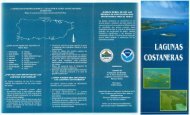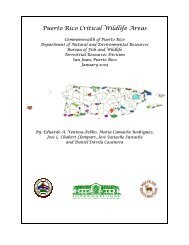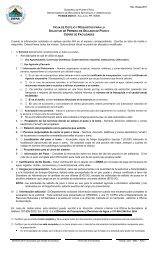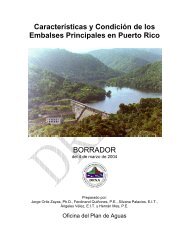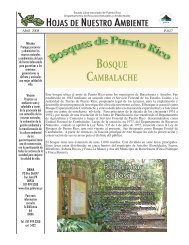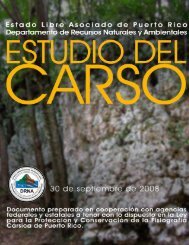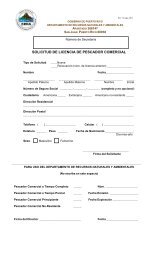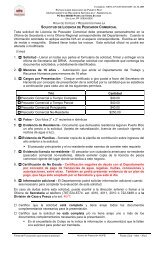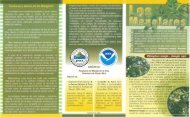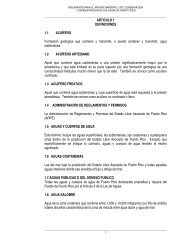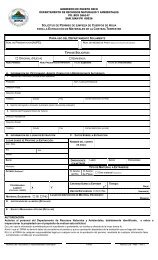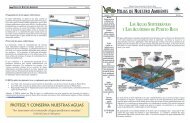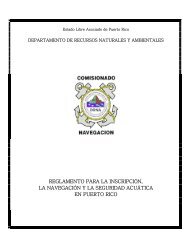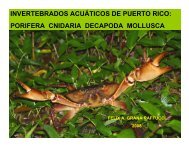determination of the spawning season of bigmouth sleeper
determination of the spawning season of bigmouth sleeper
determination of the spawning season of bigmouth sleeper
You also want an ePaper? Increase the reach of your titles
YUMPU automatically turns print PDFs into web optimized ePapers that Google loves.
concentrations <strong>of</strong> vitellogenin<br />
in March compared to<br />
wild fish, maintaining averages<br />
just below 1.0 ng/mL every<br />
month until June, when<br />
it peaked before dropping to<br />
0.0 in July (Figure 2). Minimum<br />
individual female vitellogenin<br />
concentrations were<br />
0.0 for every month except<br />
June, which had a minimum<br />
sample concentration <strong>of</strong> 1.4<br />
ng/mL. Maximum concentrations<br />
for individual females<br />
ranged from 1.7 to 3.7<br />
ng/mL from March through<br />
June. Monthly comparisons<br />
suggested no significant differences<br />
in vitellogenin concentrations<br />
between wild<br />
and captive populations (Table 2). However, wild—caught<br />
<strong>bigmouth</strong> <strong>sleeper</strong> in July had much greater concentrations<br />
than captive fish, and approached statistical significance (t 6<br />
= —2.35, p = 0.057).<br />
Estradiol<br />
The ability <strong>of</strong> <strong>the</strong> estradiol kit to accurately detect <strong>bigmouth</strong><br />
<strong>sleeper</strong> estradiol was acceptable in <strong>the</strong> range <strong>of</strong> samples<br />
tested (mean recovery <strong>of</strong> samples spiked with 1, 3, or<br />
10 ng/mL = 90.0%). However, <strong>the</strong> precision and ability to<br />
reproduce results from <strong>the</strong> same sample did not fall within<br />
<strong>the</strong> established limits (%CV < 20%) for <strong>the</strong> validation (mean<br />
inter—assay %CV = 21.7%; mean intra—assay %CV = 16.8%,<br />
range 6.4—22.8%).<br />
Plasma samples from wild—caught females contained low<br />
concentrations <strong>of</strong> estradiol in March and exhibited a slight<br />
increase in April (Figure 2). This trend was followed by a<br />
decline in plasma estradiol concentrations in May before<br />
concentrations peaked in July (Figure 2). Ano<strong>the</strong>r decline<br />
in estradiol concentrations began in August, which led to<br />
low concentrations in September and October. Minimum<br />
individual estradiol concentrations never dropped below<br />
0.05 ng/mL, which was found in October. Maximum readings<br />
for individual fish were 3.5 and 3.3 ng/mL, respectively;<br />
minimum and maximum values were recorded in April and<br />
July, respectively.<br />
Captive female <strong>bigmouth</strong> <strong>sleeper</strong> contained greater plasma<br />
estradiol concentrations in March than wild fish, and<br />
exhibited a decline in concentrations through April and<br />
May before increasing in June and peaking in July (Figure<br />
2). The minimum individual plasma estradiol concentration<br />
was 0.3 ng/mL from a female sampled in May. Maximum<br />
plasma estradiol concentrations for individual fish were 1.8<br />
and 1.9 ng/mL for March and June, respectively. Monthly<br />
Harris et al.<br />
TABLE 2. Statistical results for comparisons <strong>of</strong> reproductive development indicators between wild and captive<br />
<strong>bigmouth</strong> <strong>sleeper</strong> populations. Test statistic (T) represents a Mann—Whitney Rank Sum Test used when normality<br />
or equal variance tests failed. A Student’s t—test statistic (t) was used when normality and equal variance<br />
tests passed. Bold type indicates statistical significance at alpha level <strong>of</strong> 0.05. There were no captive fish<br />
remaining after July, so fur<strong>the</strong>r comparisons were not possible.<br />
Month Female Male Vitellogenin Estradiol Progesterone Testosterone<br />
GSI GSI<br />
March T = 20.000 T = 18.000 T = 18.500 t = 1.500 T = 11.000 t = 3.742<br />
p = 0.517 p = 0.057 p = 0.143 p = 0.133 p = 0.133 p = 0.013<br />
April T = 14.000 T = 6.000 T = 14.000 t = 1.309 t = 0.953 t = 0.267<br />
p = 1.000 p = 0.100 p = 1.000 p = 0.238 p = 0.384 p = 0.802<br />
May t = 1.267 T = 7.500 t = 1.166 t = 1.511 T = 24.000 t = 0.260<br />
p = 0.241 p = 0.114 p = 0.277 p = 0.169 p = 0.117 p = 0.808<br />
June t = 0.582 T = 18.000 t = 0.309 t = 0.106 t = 0.550 t = 1.025<br />
p = 0.579 p = 0.057 p = 0.768 p = 0.919 p = 0.611 p = 0.363<br />
July t = 2.584 T = 18.000 t = 2.351 t = 1.425 —— t = 4.033<br />
p = 0.042 p = 0.057 p = 0.204 p = 0.204 p = 0.010<br />
46<br />
comparisons between wild and captive populations found no<br />
significant differences in estradiol concentrations (p > 0.05)<br />
(Table 2).<br />
Progesterone<br />
The ability <strong>of</strong> <strong>the</strong> progesterone kit to accurately detect <strong>bigmouth</strong><br />
<strong>sleeper</strong> progesterone was acceptable (mean recovery<br />
<strong>of</strong> samples spiked with 1, 5, or 10 ng/mL = 94.4%). The precision<br />
and ability to reproduce results from <strong>the</strong> same sample<br />
was within <strong>the</strong> established limits for <strong>the</strong> validation (mean<br />
inter—assay %CV = 12.9%; mean intra—assay %CV = 9.8%,<br />
range 1.2—13.7%).<br />
Wild—caught female <strong>bigmouth</strong> <strong>sleeper</strong> showed no discernible<br />
trends in plasma progesterone concentrations, averaging<br />
between 0.2 and 0.3 ng/mL throughout <strong>the</strong> study (Figure 2).<br />
The minimum and maximum progesterone concentrations<br />
for individual <strong>bigmouth</strong> <strong>sleeper</strong> were 0.1 and 0.5 ng/mL,<br />
respectively. Both minimum and maximum values were recorded<br />
in August. Captive female <strong>bigmouth</strong> <strong>sleeper</strong> showed<br />
slightly more variation in progesterone concentrations, ranging<br />
from 0.3 to 0.6 ng/mL, with a steady decline from March<br />
to July, though <strong>the</strong> trend was not statistically significant (H 4<br />
= 8.31, p = 0.081) (Figure 2). The minimum and maximum<br />
plasma progesterone concentrations for individual captive<br />
fish were 0.2 and 0.7 ng/mL, respectively; minimum and<br />
maximum values were recorded in June and March, respectively.<br />
Monthly comparisons <strong>of</strong> wild and captive populations<br />
found no significant differences in progesterone concentrations<br />
(Table 2). Due to no discernable trends in progesterone<br />
data, no testing was conducted for progesterone in September<br />
and October.<br />
Testosterone<br />
Plasma testosterone concentrations (mean intra—assay<br />
%CV = 8.4%, range 0.6—14.2%) in wild—caught male big-



